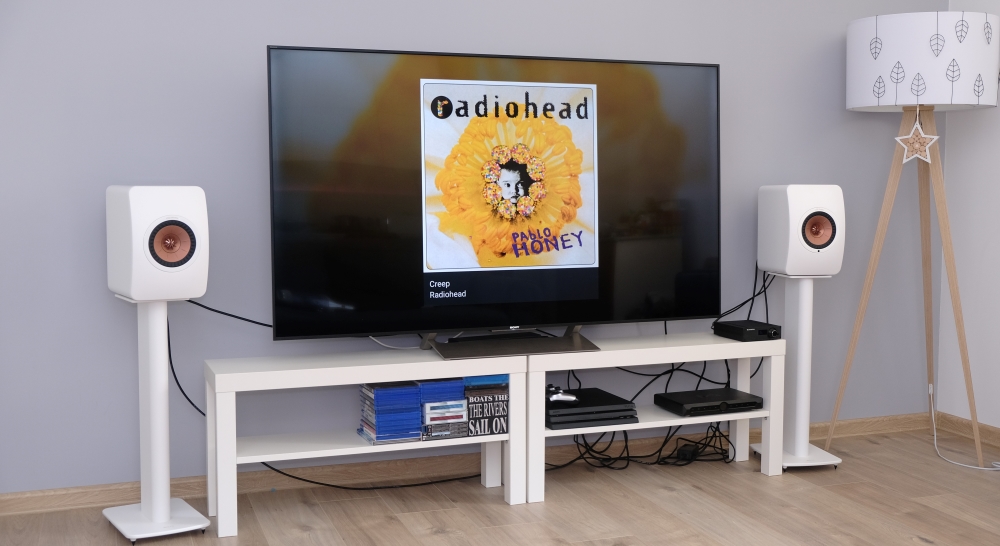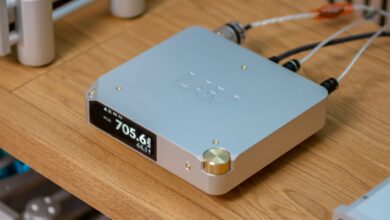
Disclaimer: The Burson Audio Swing was sent to us free of charge in exchange for our honest review. We thank team Burson Audio for that!
My video review:
2019 seems quite busy for Burson Audio, first release of the year was the extraordinary Playmate and now they offer a much-needed dedicated DAC and digital preamp called Swing.
I still remember listening to the Burson Fun and Bang and thinking that what they really need is a dedicated DAC for those units and this is how Swing came to be. As good as DAC+Amp combos are they can’t quite match separate units, Burson Play and Playmate were really good, outstanding even if you take into consideration their price points, but if you want a higher performing sound from the Burson family, Swing should be that answer.
Inside the Box
Unboxing experience is excellent! Swing came double boxed with extra foam for a good protection. Inside you’ll find: the Swing, an USB cable, a switching power supply, a power cable, a high-quality RCA interconnect cable with nice Pailics RCA jacks, an extra USB cable with a 4pin connector at the other end (connected directly to a desktop motherboard), a RCA out back-plate for a desktop computer, the premium V6 versions are also having a nice remote control, I’ve have the basic version so no remote for me. Swing also comes with an extra mini fuse in case the preinstalled out burns, a pleasant surprise.
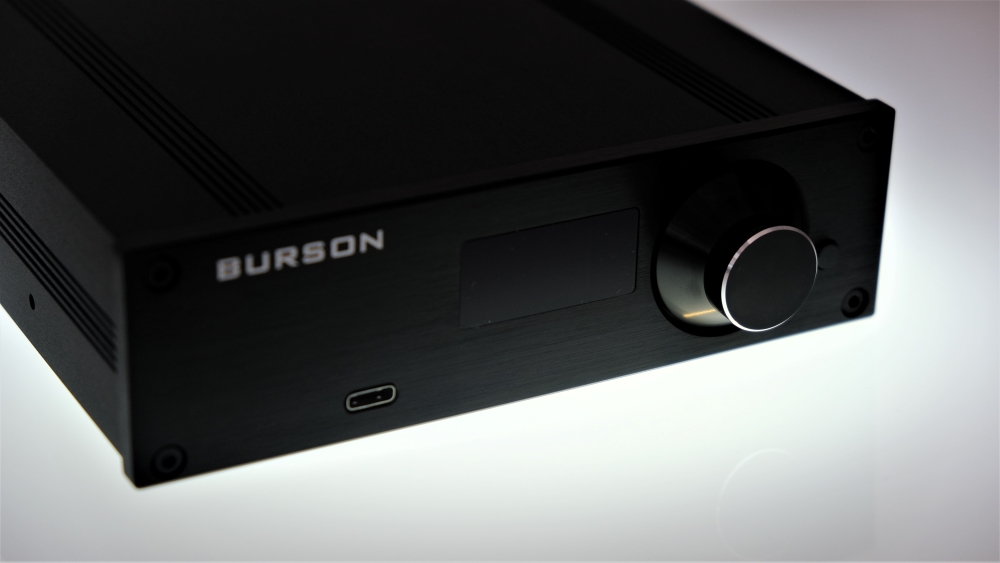
Design & Build Quality
Fit and finish is pretty good, sadly it is being offered only in a black anodized aluminum case, would love to see a raw aluminum case as well.
As their previous devices it is quite small and lightweight, at about 1.5 kg with a case that measures only 210 mm x 145 mm x 45 mm it is very easy to integrate it into tiny work spaces and offices. The final output stage is bolted directly to the case, so it will work as a big heatsink to better dissipate the heat. Swing is much cooler to the touch compared to their previous designs as it has a lower power consumption and will dissipate less heat. I think it looks nice and minimalistic, I just wish it had a slightly bigger LCD screen as listening to speakers from a distance and operating the menu with the remote is troublesome, unless you are eagle-eyed.
Inputs & Outputs
There are three digital inputs on the back: USB, Optical and Coaxial, there is also a second USB type C on the front panel in case you’ll want to use your smartphone or your DAP as a source. Swing can be powered by the external switching power supply or by your PC power supply, there is also a On/Off switch and two analog outputs: a clean 2V line-out and a volume controlled line-out – basically transforming the Swing into a digital preamp. I’m really glad Swings offers two line-outputs as comparing two integrated or headphone amps is much easier this way. On the front panel there is also a small LCD screen, a digitally controlled volume potentiometer and a menu button.
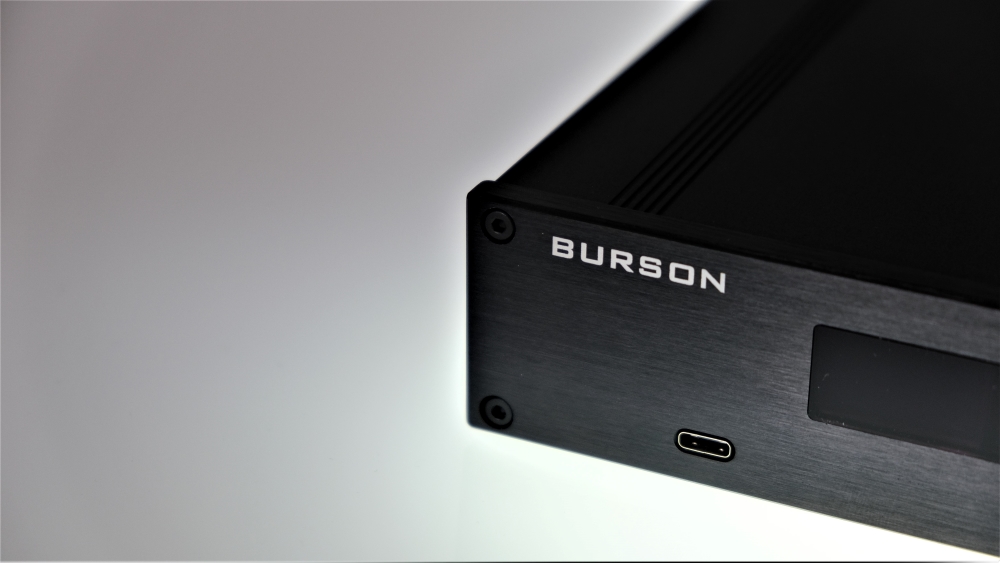
Under the Hood
As the Play, Playmate, Fun and Bang, Swing can also be integrated inside your desktop PC in place of a 5.25” drive bay. You have two options when it comes to feeding the Swing: the external switching PSU or your PC PSU, but you’ll need a powerful and stable PSU since Swing will drain 12V and up to 5A of power.
My desktop computer doesn’t have drive bays so I only used the supplied external PSU, which worked really well. In general, I am not a big fan of the switching power supplies because of weak dynamics and dirty background but since Burson developed their legendary Max Current Power Supply inside their Swing, the switching PSU becomes a non-issue anymore, I really like the Burson’s approach.
Of course, the Swing will sing using a very high-performance DAC chip, it is being powered by a stereo ES9038Q2M chip that is considered top class, it is not the 8-channel PRO version, I’m OK with that, will tell you why in our comparison at the end of the article.
Swing is also using a high-performance USB interface: XMOS XU-208 that is also used in much more expensive designs, even my own 1800 USD Matrix X-Sabre PRO is using it, which I find quite interesting. Of course, the XMOS interface is free of weird noises, hum or any interference via USB, so that is a good sign.
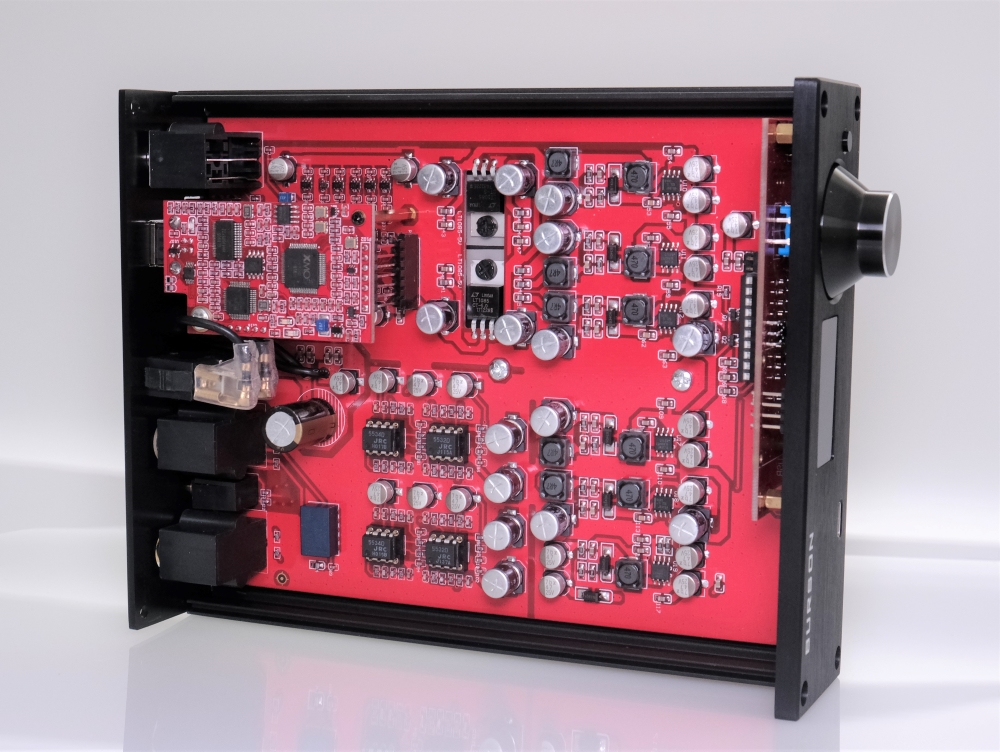
High quality audio grade electrolytic capacitors from ELNA are spotted here and there but none of them are in the signal path!
Toshiba discrete transistors can also be spotted, Dale military grade transistors as well, a very well-made DAC from the technical point of view.
As the Playmate, Swing is also using Burson made Max Current Power Supply (MCPS), this one overcomes the issues of both transformer based linear power supplies and conventional switching power supplies. Of course, this MCPS is tuned to work in class-A for a black as nigh background.
Swings has four DIP8 socketed op-amps, I am however rocking the Basic, east-European friendly version that is powered by two NE5532 single op-amps and by another two NE5534 dual op-amps. All four are DIP8 versions and can be swapped with higher performance op-amps like Burson’s own V6 Classic and V6 Vivid offerings. The Basic one can be had for 400 USD and the most advanced one for 700 USD, a 300 USD difference for the upgraded op-amps. If you want the most advanced version, here is a tip for you, put in your cart the Basic version and separately a pair of single V6 and a pair of dual V6 op-amps and you will save exactly 100 USD with that wombo-combo! You’ll thank me later.
Menu Options
I’m glad Burson opted for an LCD screen on the front panel, it will show important information as your volume level (for the preamp out), your selected output, your digital stream of PCM or DSD and the bitrate.
Pushing the small button on the far-right enters the menu where a lot of settings can accessed as:
1. You can select 4 digital inputs: USB type C, type B, Optical and Coaxial. I used USB type B and Optical input from my ChromeCast enabled TV, both worked excellent.
2. You can select your output: DAC out or preamp out. If you select the preamp output the volume wheel will start working and on the display the volume setting will be displayed.
3. You can select the pre level, basically a preamp gain: Low or High, I recommend the default High setting. For very sensitive active speakers you can use the Low setting.
4. Selectable digital filters that are built-in directly in the ESS DAC chip. You can play with them to tailor the sound to your liking. There is a faint difference between them, I prefer the LP Fast by a small margin.
5. DPLL for DSD and for PCM data streams, the higher the setting is the higher the jitter rejection will be, left it on high position.
6. Emphasis – I’m glad it is on “Off” position by default. Putting it on “On” position will roll-off the treble by about 5dB at 10 kHz and by about 8dB at 20 kHz. I strongly recommend leaving it at “Off” position for the best performance and the most accurate frequency response.
7. Reset all settings: self-explanatory
Thumbs-up team Burson for implementing a cool menu and few must-have settings.
Now, let’s get to the most interesting part, shall we?

Sound Performance
I. Using the Swing in a headphone-based system
I first used the Swing with few of my headphone amps obviously connected to some sensitive IEMs and desktop class headphones. Since Swing has two outputs it is really easy comparing two headphone amps on the same DAC, in this regard it is a reviewer’s dream.
First thing I noticed is that it has a very black background, free of any type of noise, even my sensitive IEMs didn’t pick up any noise. To some degree it has an even cleaner presentation that the all in-one Playmate has, and should I remind you as stated in my review, Playmate was already great with IEMs.
This is obviously a Burson design if first thing that tickled my ears was a hard kicking, eardrum slamming presentation. If you think an ESS based design should sound on the dry side with lots of digitus and harsh treble, think again. I really don’t know what secret sauce Burson is pouring over its designs but they always sound so engaging, so alive, natural and hard kicking, seems that Swing is no exception to that rule.
Carefully selected analog parts plus a very revealing chip yielded the best of both worlds, it has great resolution and transparency levels and lots of grunt, slam and an easy-going natural presentation.
Swing is mostly linear and has an excellent frequency range, without cutouts in the lower or upper registers, from lowest base to upper treble there is definition and clear outline of every note. I said mostly because I believe the mid-bass and the midrange is a bit on the warmer side to always infuse a little bit of joy and euphoria to the listener.
Depth is in the big boy category with excellent pin-point imaging for a very 3D sound around the listener.
Since soundstage on headphones is not as easy to define as it is on speakers, I moved my listening to the living room.
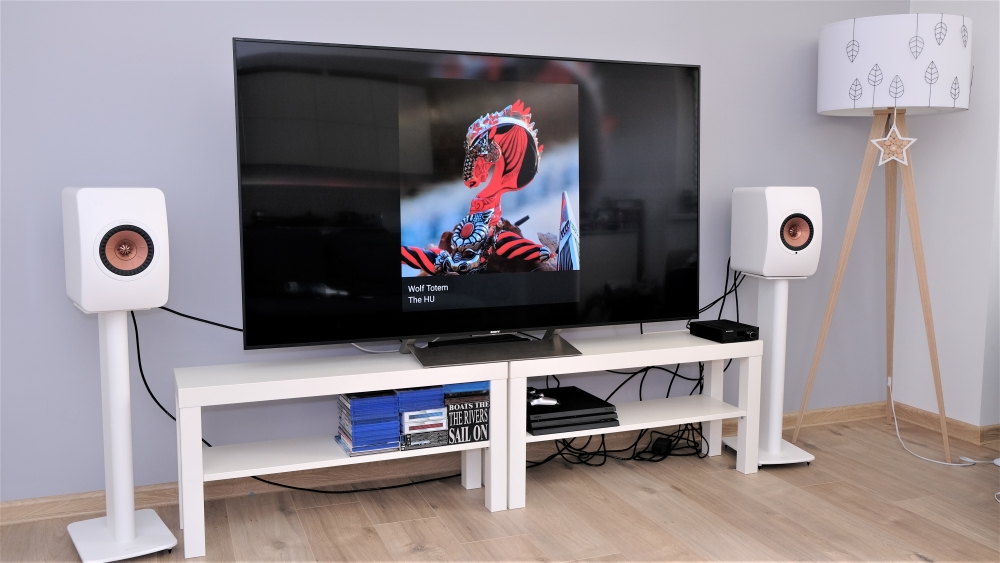
II. Using the Swing in a speaker-based system.
My KEF LS50W are basically a 4-in-1 system consisting of a Hi-Res DAC, a streamer, a dual-mono amplifier and a pair of coaxial speakers. However, they offer a pair on RCA analog inputs, just in case I want to connect a better DAC to them and this is exactly what I did.
My TV has a built-in Chromecast Audio and an optical output, so connecting to Swing was a 1-minute job streaming lossless files via Tidal.
First thing that hit me was how much cleaner it sounded compared to the built-in Hi-Res DAC. Detail retrieval is certainly on a higher level and almost pulled to the extreme. Frequency response is just exceptionally reproduced, from the lowest base to the highest musical notes, everything is crystal clear, I’m easily spotting imperfections in the recordings, like a chair is being moved in the studio, like singers are moving their feet. Everything just becomes a simple game of imagination.
Of course, the same speed and impact I’ve heard on headphones was very present here as well. Unlike other cheaper alternatives I recently covered (Loxjie D20 and xDuoo TA-10), Swing doesn’t have timing errors and has a high degree of precision.
Listening to instrumental music mixed with some rock and folk tunes, everything sounded easy going and quite natural, neither syrupy, neither dry, with an exact dose of naturalness and technical precision.
Listening to a fast and crowded recording I never felt that Swing is losing its pace, rhythm or timing, or that is chocking and mixes musical notes into a muddy audio blob, that will never happen.
Every note is being played in its own air-bubble with a big void between them. Swing is not crowded or forward sounding and that is a good thing.
I can rarely describe am ESS Sabre based DAC as being natural sounding, musical and a bit sweet, but Burson with their secret audio sauce is proving that everything is possible and Swing is an exception to that formula.
In my opinion Swing has a very good tonal balance with a mix of technical prowess and musical enjoyment, it will never sound boring, dry, toneless and will never lack dynamics.
Listening to some old rock tunes I was curious if the vintage and a bit distorted sound will be still intact and to my surprise it sounded as I remember it on much higher priced DACs. That analogue grain and flow was still intact, the imperfections of the recording are still there but those are not scratching my ears and are not screaming for my attention. I’m glad the soul of those recordings is still there.
Passing through my ’90 electronica it was clear to me that impact and slam are again on a high level.
I could not characterize it as lightning quick, more like thunder quick, but still everything is fast with excellent rise and decay of the notes. I started feeling the impact with my whole body not only with my ears.
Fun factor is phenomenal and the mix created by the electric guitars and digital sounds is so well played, I can easily pick a single sound and focus my hearing only on it with ease.
At last I can freely write about soundstage and its size. Music is spread not only in a 2D field, every note will have a X, Y and Z axle and you can feel and hear the distance between yourself and that note. Soundstage is on the wider side so I can look into and easily analyze every track and every individual sound. Sounds are reaching me with longer decays on speakers so I am having plenty of time analyzing the stage and nuance of every note.
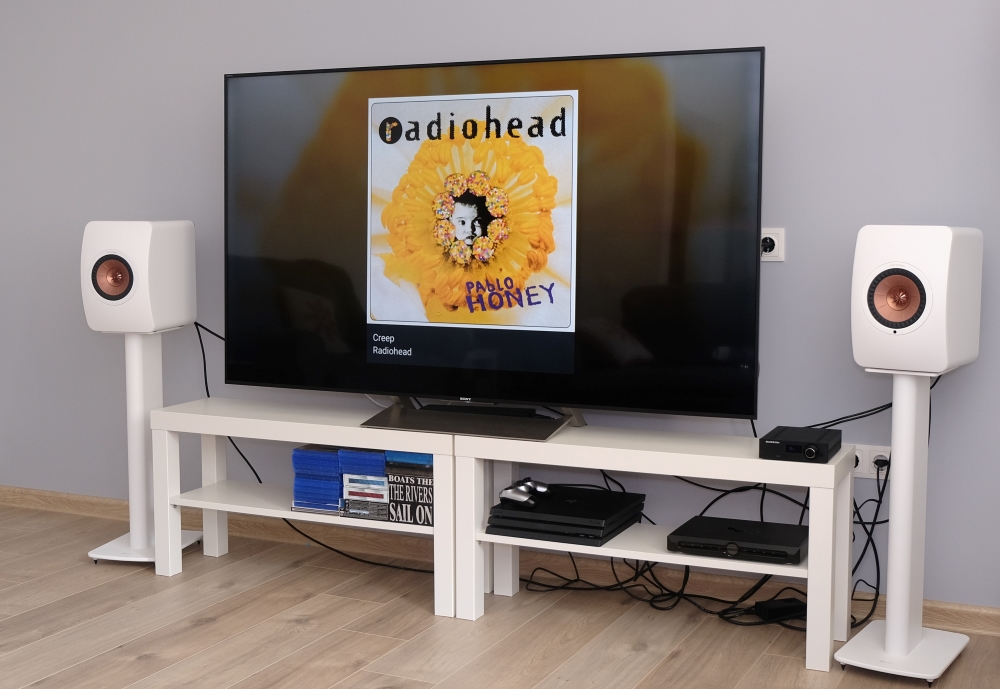
Comparisons
Burson Playmate Basic (400 USD) VS Burson Swing Basic (400 USD)
I briefly compared the Burson Playmate Basic with the Burson Swing basic, both priced at 400 USD. Playmate is having also a headphone amp section; however, Swing is rocking an extra digital input (coaxial) and an additional line-out. Build quality wise both are identical and look the same.
When it comes to sound performance the difference is really small but there is still a difference.
Swing has a nicer frequency response and will extract more information up top, I’ve heard it on speakers and on headphones as well, especially in the upper treble Swing has just higher amount of information and it is just a smudge cleaner sounding. Playmate has a slight treble muddiness and with Swing that is completely gone.
Listening on speakers the air bubbles of the notes are bigger on the Swing, not by much but noticeable. Apart from that, soundstage size and depth are equally impressive.
Next test was even more interesting…
Matrix X-Sabre PRO (1800 USD) VS Burson Swing Basic (400 USD)
I am very familiar with my X-Sabre Pro and I know its presentation extremely well. This test was mainly done using my headphones since my headphone amp has two analog inputs and a simple switch to change between them. So, comparing two DACs was really easy, especially on a nice pair of revealing headphones.
I started listening to the same track I listened previously and started flipping the switch, I volume matched both sources for a more critical listening.
To my big surprise the difference was much smaller than I anticipated and in a blind listening test I might fail picking one from the other. The same natural, fast, impactful presentation was heard on both devices. Hell, even the detail retrieval was almost on the same level, it was on the same page for sure. X-Sabre Pro was ahead by just a hair!
Speaking about naturalness and musicality Swing jumped ahead with just a better flow, it was really grain-free in the long run. X-Sabre Pro will still extract more information and will catch your attention more often and will not be as smooth and musical in the long run.
Swing certainly didn’t sound 4.5 times worse than the Pro; both will complement each other and will be side-grades than unquestionable upgrades. This way a bit unexpected.
Soundstage wise both sounded the same, so I again moved my listening tests to my living room and there I saw the biggest improvement on the X-Sabre Pro as it just sounded grander and deeper.
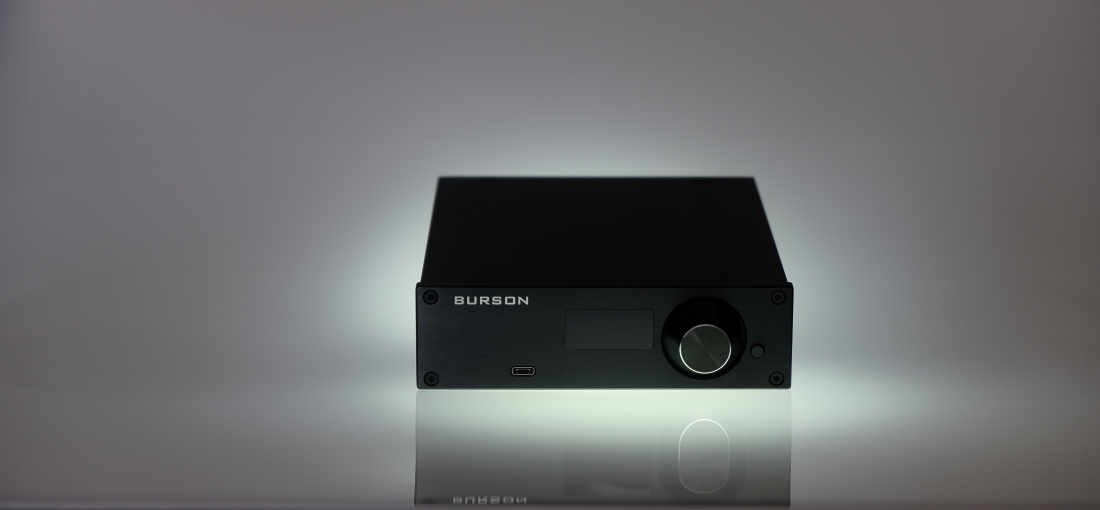
Conclusions
So here we have it folks, a mighty sounding DAC and digital preamp at the cost of a nice pair of cables.
I’m glad Burson finally released a standalone DAC in their line-up, they didn’t do it for about 8 years now, their last such device was the DA-160. Burson Fun and Bang users can easily sleep now as they have a new target on their radar.
Swing in unquestionable an excellent performing DAC in a speaker-based on headphone-based system. As such, it’s an easy recommendation, at 400 USD it’s simply a must buy. Speaker users be warned though, the basic version does not have a remote control in the package and the LCD screen is fairly small, go with the upgraded version for that nice metallic remote.
Burson Swing can be purchased directly from Burson Audio, here’s a link
PROS:
- Impressive frequency response and tonal balance
- Natural sounding, grain-free with a good flow
- Wide soundstage and good depth, not forward at all
- Thunder speed and impact
- Lots of features, inputs and outputs
- Awesome price to performance ratio!
CONS:
- Basic version lacks a remote
ASSOCIATED EQUIPMENT:
- DACs: Burson Swing & Playmate, Matrix X-Sabre Pro, Loxjie D20, xDuoo TA-10
- Headphone Amps: HeadAmp Gilmore Lite Mk2, Erzitech Bacillus, Burson Playmate, xDuoo TA-10
- Speakers: KEF LS50W
- Headphones: Quad ERA-1, Sennheiser HD660S, Sennheiser Momentum 2, FiiO FA7, FH7
- Cables: QED Reference XLR, Burson Cable+ PRO, Audioquest & Kimber interconnects, PS Audio power cables
